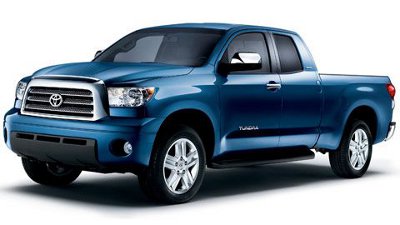Tundra Exhaust Videos
- 2000 Toyota Tundra Exhaust Systems
- 2001 Toyota Tundra Exhaust Systems
- 2002 Toyota Tundra Exhaust Systems
- 2003 Toyota Tundra Exhaust Systems
- 2004 Toyota Tundra Exhaust Systems
- 2005 Toyota Tundra Exhaust Systems
- 2006 Toyota Tundra Exhaust Systems
- 2007 Toyota Tundra Exhaust Systems
- 2008 Toyota Tundra Exhaust Systems
- 2009 Toyota Tundra Exhaust Systems
- 2010 Toyota Tundra Exhaust Systems
- 2011 Toyota Tundra Exhaust Systems
Tundra Exhaust System Tips
 When the revised Toyota Tundra was introduced in 2007, it turned a lot of heads. Finally, Toyota was offering a full-size pickup truck that was a match in terms of power, form factor and capability when compared against its domestic rivals. Aftermarket exhaust companies took notice too, thanks to the decision to include a fire-breathing 381 HP 5.7L V8 as the Tundra’s power plant of choice.
When the revised Toyota Tundra was introduced in 2007, it turned a lot of heads. Finally, Toyota was offering a full-size pickup truck that was a match in terms of power, form factor and capability when compared against its domestic rivals. Aftermarket exhaust companies took notice too, thanks to the decision to include a fire-breathing 381 HP 5.7L V8 as the Tundra’s power plant of choice.
Toyota has always been known for building high quality vehicles, but many in the pickup truck world were not aware that it also harbored a high performance division. Called TRD, the engineers responsible for tuning the Tundra were able to come up with a number of enhancements for the brawny truck, including a complete exhaust system.
There are four engines of note to be had in the most recent edition of the Toyota Tundra:
- A 4.0L V6
- A 4.7L mid-range V8 engine good for 271 horsepower
- A 310 horsepower, 4.6L V8 that replaced the 4.7L in 2010
- The top of the line, 5.7L iForce eight-cylinder engine that generates an exceptional 381 horsepower.
The iForce unit is the taskmaster of the group, and its prodigious output has seen it targeted by aftermarket exhaust companies looking to build the same kind of market with Toyota buyers that they already enjoyed with domestic truck buyers. The newer 4.6L unit, however, also offers a lot of potential for exhaust tuning and it is gradually gathering steam amongst performance exhaust brands.
Many different exhaust manufacturers service the Toyota Tundra:
Evidently, the Tundra has managed to work its way onto the agendas of most of the major players in the truck exhaust world. Anything from headers to exhaust tips to full systems can be installed under the full-size truck, giving Toyota owners the same range of options that any other full-size truck brand enjoys in North America.
Toyota Tundra Exhaust Recommendations
1. Sound or fury? If all you want is a great sounding exhaust note, then a set of mufflers is most likely going to be sufficient. If you want to tap into the full potential of the Tundra’s iForce V8, then headers and a full system will be required.
2. Be aware of the market. Toyota’s mid-range V8 options can offer serious snarl out of the exhaust pipes, but don’t necessarily have the same aftermarket support given to the 5.7L unit – yet. Don’t get frustrated – that’s just the way it is. The V6, on the other hand, can take advantage of some of the components out there aimed at the Toyota Tacoma application of the same engine.
3. Remember TRD. It might not be the least expensive exhaust option, but the engineering and warranty that come with a factory TRD exhaust – and the fact that a TRD exhaust can be included in new vehicle financing – are strong points in its favor.









Trackbacks & Pingbacks